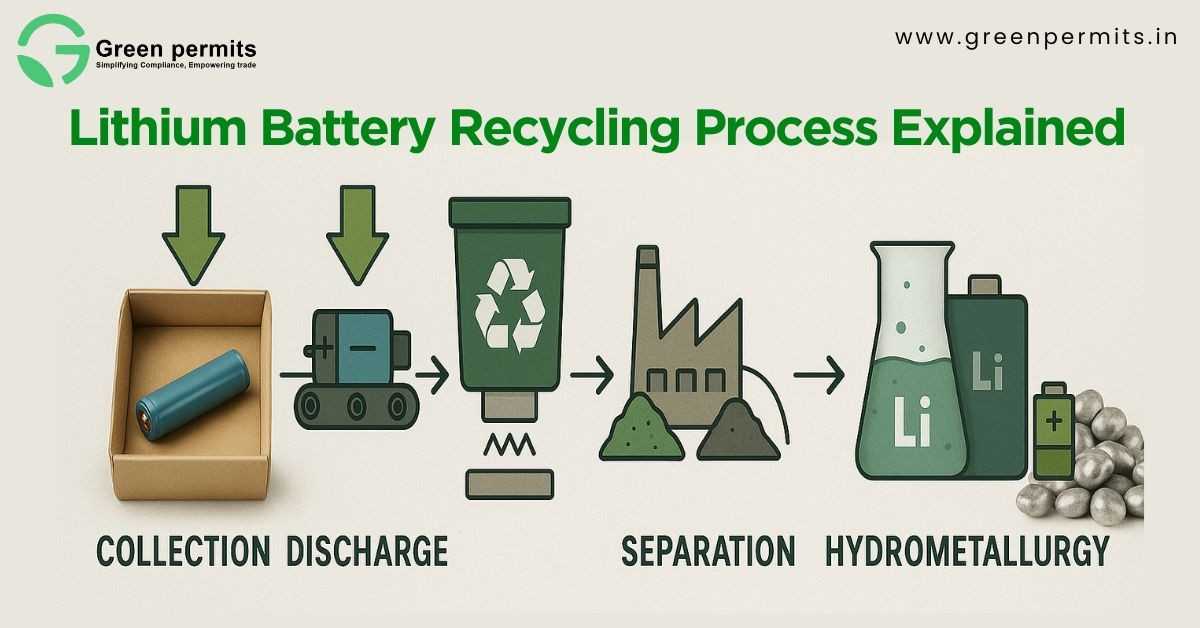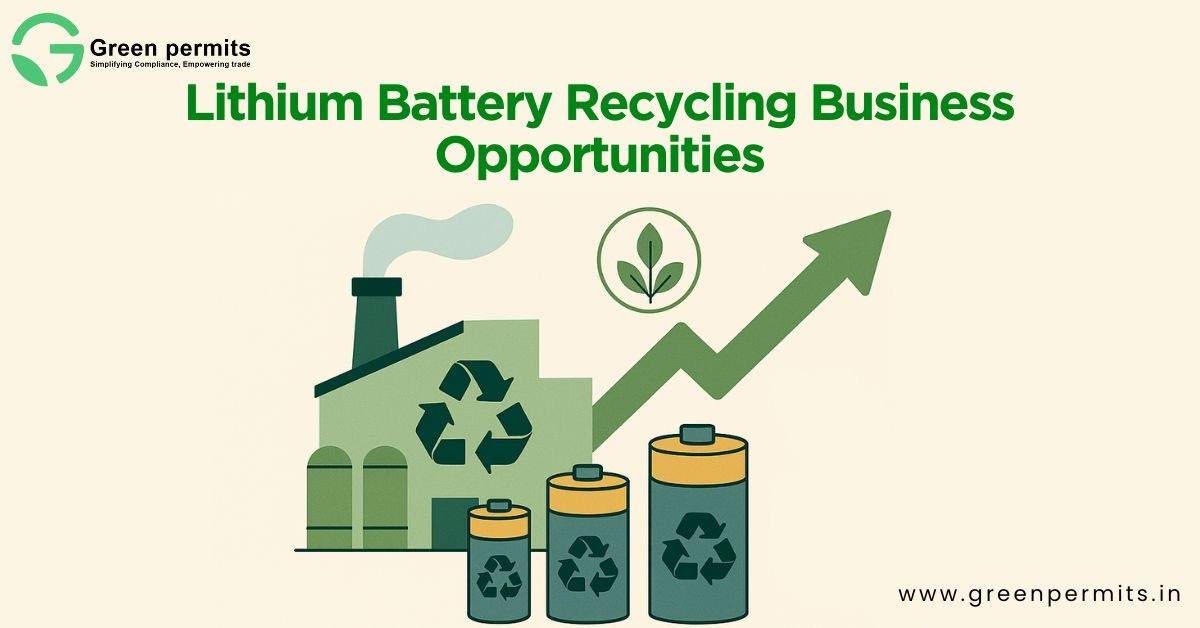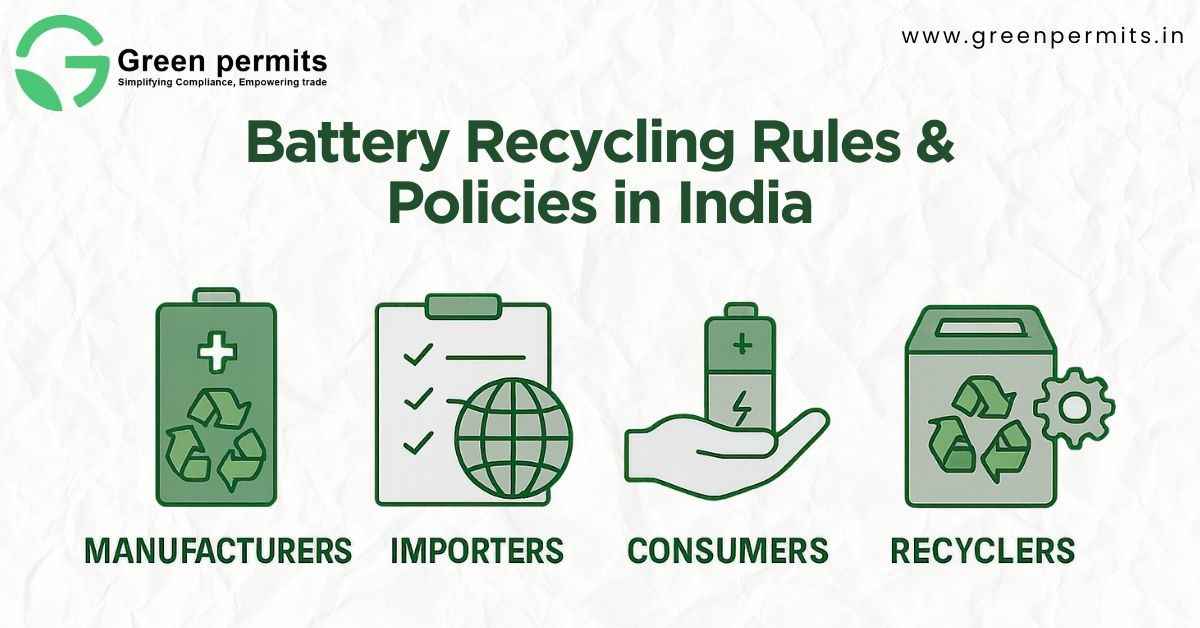Introduction
Lithium-ion batteries are everywhere — in your phone, your laptop, your electric scooter, and even in solar power storage. But what happens when these batteries stop working? In India, they can’t simply be thrown in the dustbin. Under the Battery Waste Management Rules, 2022, they are treated as hazardous waste and must be recycled responsibly.
For a business owner or compliance head, this isn’t just about protecting the planet. It’s about staying on the right side of the law, avoiding penalties, and even unlocking new revenue streams. Let’s break down the recycling process step by step, and see why it matters for you.
Why Lithium Battery Recycling Matters
Lithium batteries contain valuable metals like cobalt, nickel, lithium, and copper. If dumped carelessly, they can leak harmful chemicals, cause fires, or pollute soil and groundwater. Recycling prevents this damage and recovers these precious resources.
- India’s EV battery waste could reach 50,000 metric tonnes by 2030.
- Recycling helps India reduce its dependency on imports of metals like cobalt and nickel.
- Companies that recycle also generate EPR certificates that can be traded to meet compliance obligations.
Think of recycling as both a safety measure and a business opportunity.
Step 1: Collection and Transportation
The first step is simple but crucial — collecting old batteries. These come from consumers, showrooms, service centers, telecom companies, and even solar installations.
Only registered collectors and transporters can move these batteries, since they are classified as hazardous. Proper storage and safe transport reduce the risk of fire or leakage.
Step 2: Sorting and Dismantling
At the recycling facility, batteries are sorted by type. A lithium-ion cell looks very different from a lead-acid battery, and each has a different recycling path.
Once sorted, the battery packs are carefully dismantled. This is delicate work — one wrong move can cause a fire. Recyclers also need to record their process with geo-tagged videos and pictures to stay compliant with CPCB requirements.
Step 3: Shredding and Black Mass Production
The dismantled cells are fed into shredders inside safe, controlled chambers. The output is a powdery mixture called black mass. This black mass is rich in lithium, cobalt, nickel, and manganese.
Alongside, other materials like copper, aluminum, and plastic are separated and stored for further processing.
Step 4: Metallurgical Processing
Now comes the core of the recycling process. There are two main techniques:
- Pyrometallurgy
- Uses high-temperature smelting.
- Recovers nickel, cobalt, and copper efficiently.
- Lithium often gets lost in the slag.
- Hydrometallurgy
- Uses acid solutions to leach out metals.
- Higher recovery rates for lithium and cobalt (often more than 90%).
- Requires proper wastewater treatment to stay eco-friendly.
Globally, hydrometallurgy is becoming more popular because it’s more efficient and less damaging to the environment.
What Metals Are Recovered?
| Battery Type | Key Metals | Average Composition |
|---|---|---|
| Lithium-ion (general) | Li, Ni, Co, Cu, Al, Fe | Lithium 1–5%, Nickel 12–16%, Cobalt 8–12%, Copper 12–18% |
| NMC (Nickel-Manganese-Cobalt) | Ni, Mn, Co, Li | Nickel 12–16%, Manganese 4–8%, Cobalt 8–12% |
| LFP (Lithium Iron Phosphate) | Li, Fe, Al | Lithium 1–2%, Iron 40–45%, Aluminium 5–10% |
This is where the money lies — the recovered metals can go back into the supply chain for making new batteries.
Step 5: Refining and EPR Certificates
Once the metals are refined, recyclers sell them to manufacturers. But here’s the compliance twist — recyclers also generate Extended Producer Responsibility (EPR) certificates.
These certificates represent the amount of metal recovered. Producers and importers are legally required to buy these certificates to prove they’ve met their recycling obligations.
For example, if 1,000 kg of lithium-ion batteries are recycled and 90 kg of cobalt is recovered, an EPR certificate for 90 kg is generated.
Compliance Framework in India
| Requirement | Fee / Obligation | Authority |
|---|---|---|
| New recycler registration | ₹15,000 (valid 5 years) | CPCB / SPCB |
| Renewal | ₹7,500 + fee per MT processed | CPCB |
| Annual maintenance | ₹5,000 | CPCB |
| Annual return filing | Due by June 30 every year | CPCB portal |
This system ensures transparency and traceability.
Risks of Non-Compliance
Here’s the catch — non-compliance is costly.
- If you operate without CPCB registration, your business can be shut down.
- Providing false data can get your license revoked for a year.
- Missing EPR targets can attract environmental compensation charges, which have run into lakhs of rupees for some companies.
In 2023, several importers in Delhi faced penalties because they missed their recycling obligations.
Real-World Examples
Gujarat Recycler Success
A small recycler in Vadodara set up a 500 MT per year hydrometallurgical unit. By following CPCB’s SOPs and maintaining geo-tagged compliance videos, they received registration in 90 days. Today, they not only recover metals but also sell EPR certificates to EV companies.
Delhi Importer Penalty
A mid-sized electronics importer ignored compliance for two years. When audited, they were fined ₹12 lakh. After registering and filing past returns, they managed to regularize operations — but the financial and reputational hit was heavy.
Why Businesses Should Act Early
Recycling compliance isn’t just about avoiding penalties. Acting early can help businesses:
- Launch products faster without regulatory delays.
- Earn from trading EPR certificates.
- Build brand reputation as a responsible, sustainable company.
FAQs
It’s the powder left after shredding lithium-ion cells. It contains cobalt, lithium, nickel, and other metals.
Yes. Under the 2022 rules, producers and recyclers must register and meet EPR targets.
A medium-sized plant with 2,000–5,000 MT capacity needs an investment of ₹25–50 crore, depending on the technology.
You may face environmental compensation charges, which can run into crores for bigger companies.
Yes. Recyclers generate certificates based on metals recovered, which producers buy to meet obligations.
The Central Pollution Control Board (CPCB) along with State Pollution Control Boards (SPCBs).
Conclusion
Lithium battery recycling is no longer optional — it’s a legal necessity in India. Businesses that ignore compliance face fines, delays, and even suspension of operations. But those who act early can turn waste into opportunity, gain new revenue from EPR trading, and strengthen their ESG credentials.
If you’re a business dealing with lithium batteries, now is the time to prepare. The process is complex, but with the right guidance, it can be simple, profitable, and fully compliant.
📞 Call us at +91 78350 06182
📧 Email: wecare@greenpermits.in
Book a Consultation with Green Permits









